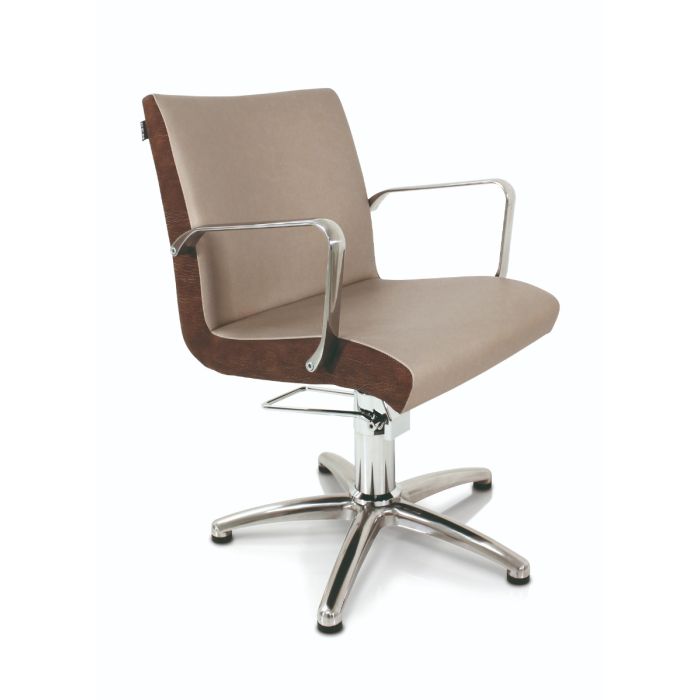
How to Maintain Your Salon Styling Chair in the UK for Long-Term Performance
Share
By building maintenance into your business plan, you protect your salon’s bottom line and reinforce a reputation for reliability.. The last thing you want is equipment failure disrupting appointments. A well-maintained salon styling chair not only extends the lifespan of your investment but also protects your reputation with clients who expect comfort, hygiene, and professionalism.
In this guide, we’ll cover the key aspects of maintaining salon chairs for UK hairdressers, barbers, and beauty clinics, including cleaning, servicing, compliance, and cost-saving strategies.
Why is regular salon chair maintenance essential in UK salons?
Salon chairs are in daily, heavy use. Over time, wear and tear on hydraulics, upholstery, and bases can lead to squeaks, leaks, or worse — unsafe seating for clients. In the UK, where health and safety compliance is tightly regulated under the Provision and Use of Work Equipment Regulations (PUWER), neglected equipment can expose salon owners to liability.
Consistent chair maintenance not only ensures safety but also supports a more professional atmosphere, which directly affects client satisfaction and repeat bookings. From a financial perspective, proactive servicing reduces the risk of expensive emergency repairs or premature replacement.
How should you clean and disinfect salon chairs to meet UK hygiene standards?
Hygiene is a non-negotiable in UK salons, especially under the scrutiny of local councils and environmental health officers. The chair is one of the most frequently touched items in your workspace.
Upholstery care and disinfection
Use a mild soap solution or designated salon upholstery cleaner for daily wipe-downs.
Avoid harsh chemicals like bleach that can degrade PU or vinyl commonly used in UK salon chairs.
Apply approved salon disinfectants that comply with UK COSHH regulations to control infection risks.
Armrests, footrests, and bases
These are often overlooked but frequently touched. A simple daily clean prevents build-up of dirt, hair, and bacteria.
Consistent cleaning routines not only reassure clients but can also be logged for inspection, demonstrating compliance with UK hygiene standards.
What are the best practices for maintaining salon chair hydraulics?
The hydraulic pump is the heart of a styling chair. In busy UK barbershops and salons, repeated pumping and height adjustments put significant strain on this mechanism.
Checking hydraulic performance
Watch for sinking during use — this signals fluid leaks or worn seals.
Inspect regularly for oil marks on the base, which indicate slow leaks.
Servicing and fluid checks
Hydraulic systems require occasional lubrication and, in some cases, topping up with hydraulic fluid. UK salon owners should schedule a six-monthly check-up, either in-house if confident, or via a professional service technician familiar with salon furniture.
By catching early issues, you avoid sudden breakdowns during peak trading hours — protecting both revenue and client experience.
How do UK salons protect chair bases and flooring from damage?
In the UK, many salons operate in rented high-street premises where flooring must be kept in excellent condition to avoid deposit losses or repair costs. Chair bases, particularly heavy disc or star bases, can scuff wooden, vinyl, or tiled flooring.
Protective solutions
Use purpose-built salon chair floor mats, which also reduce stylist fatigue.
Inspect casters (if fitted) to prevent dragging damage.
Casters are the little wheels sometimes attached to salon chair bases. Over time, if they get clogged with hair or aren’t rolling smoothly, they can scrape or drag across the floor, leaving marks or gouge
Ensure chair bases are correctly tightened
This is to reduce wobble that can damage both flooring and the chair’s stability. Proactively protecting both your flooring and your chair base reduces long-term costs and preserves a professional salon image.
What role does UK compliance and safety testing play in chair maintenance?
Unlike generic advice, UK salons must specifically account for Portable Appliance Testing (PAT) where electrical chairs are used (such as backwash units with massage functions). While hydraulic styling chairs don’t require PAT testing, regular safety inspections fall under PUWER.
Responsibilities for UK salon owners
Ensure chairs are installed and adjusted correctly to prevent client injury.
Keep a maintenance log to demonstrate compliance if inspected by insurers or local authorities.
Replace or professionally repair damaged chairs immediately rather than risking temporary fixes.
By embedding compliance into your maintenance routine, you protect both your business and your staff.
How can regular chair maintenance reduce costs for UK salons?
With rising operational expenses in the UK hair and beauty sector, cost efficiency is a priority. Skipping maintenance often leads to higher repair bills later.
Financial benefits of proactive care of your styling chair
Extends the working life of a styling chair, delaying costly replacements.
Prevents sudden breakdowns during peak hours, avoiding lost bookings.
Improves client retention by maintaining comfort and professional presentation.
Conclusion
For UK salon professionals, maintaining styling chairs is not just about appearances — it’s about compliance, cost control, and client trust. A structured cleaning, servicing, and inspection routine will keep your equipment safe, your clients comfortable, and your salon running smoothly.
At Zen Salon Supply UK, we provide industry knowledge to help you make informed decisions about your equipment and protect your long-term investment.
